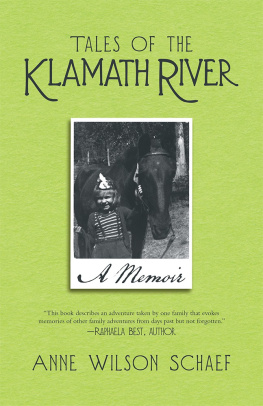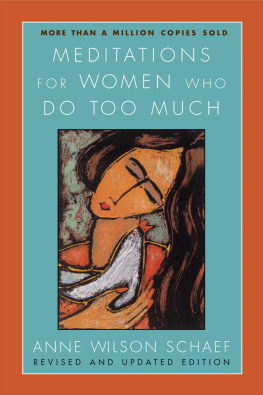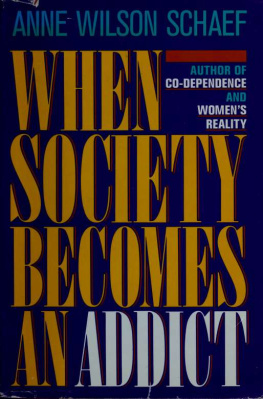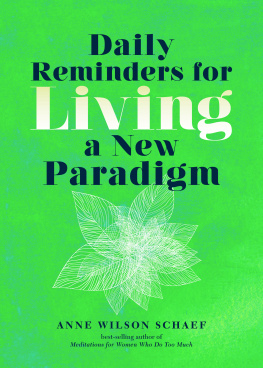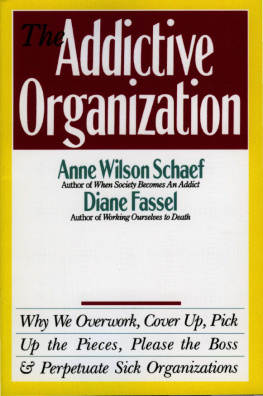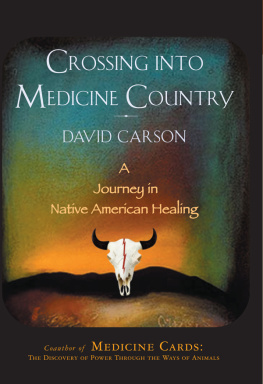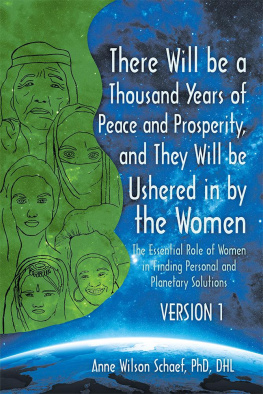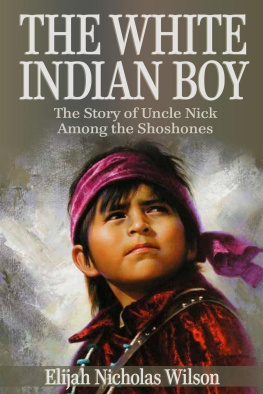TALES OF THE
KLAMATH RIVER
A Memoir
ANNE WILSON SCHAEF

TALES OF THE KLAMATH RIVER
A MEMOIR
Copyright 2018 Anne Wilson Schaef.
All rights reserved. No part of this book may be used or reproduced by any means, graphic, electronic, or mechanical, including photocopying, recording, taping or by any information storage retrieval system without the written permission of the author except in the case of brief quotations embodied in critical articles and reviews.
iUniverse
1663 Liberty Drive
Bloomington, IN 47403
www.iuniverse.com
1-800-Authors (1-800-288-4677)
Because of the dynamic nature of the Internet, any web addresses or links contained in this book may have changed since publication and may no longer be valid. The views expressed in this work are solely those of the author and do not necessarily reflect the views of the publisher, and the publisher hereby disclaims any responsibility for them.
Any people depicted in stock imagery provided by Getty Images are models, and such images are being used for illustrative purposes only.
Certain stock imagery Getty Images.
ISBN: 978-1-5320-5054-1 (sc)
ISBN: 978-1-5320-5055-8 (e)
Library of Congress Control Number: 2018908213
iUniverse rev. date: 11/07/2018
CONTENTS
The great thing about getting older is that you dont lose all the other ages you have been.
Madeline LEngle
I dont have an inner child. I have the living child who is a full participant and contributor to who I am and who I will become.
Anne Wilson Schaef
No journey begins, exists, or ends in isolation. It starts in an ongoing context of processes, is, itself, a process and it only ends when we let it or refuse to remember that all is in context and in process.
Anne Wilson Schaef
As I read through this manuscript for the final editing, I am aware of how alive, after seventy-eight years, these people, their world and my experiences with them and with my family continue to be for me.
The world in which we were living in these stories is still a world that exists for all of us, yet it is getting buried deeper and deeper as time goes on. Our family, seventy-eight years ago, went from Indian Country in Oklahoma to Indian Country in California an Indian Country that few white people knew and much of California knew nothing about at that time. The year was 1939, post First World War and pre Second World War. It was a time of interlude, when many still lived in the old ways.
As I reread what I had written, I realized that there are really three authors to this book.
Of course I give myself, Anne Wilson Schaef, an eighty-three-year-old woman, top responsibility because I actually put the words down on paper.
Then, there is my father, Virgil Eustace Willey, who was gracious enough to record his memories and perceptions before he died. It was very important to him that this story be told and I carried that mandate around with me until, while doing an Ayurvedic cure in India, I found the time to retreat from my busy Western world and remember. What a joy it was to have the time to relive this precious sojourn with its long-past experiences.
Then, as I read, I discovered a third person had crept into the manuscript as an author too. That five-year-old girl had been patiently waiting for me to be responsible. She spoke in her own idiom, expressions and perceptions out of her own clarity of memory, which was often much more intuitive, perceptive, visual and different from mine. I was amazed at how clear her memories and her voice were. Often, she had to step forward and say, No, Anne, thats not quite right. This is the way it was. Invariably, I knew she was right.
Thus, the major author is the five-year-old Elizabeth Anne Willey, who turned out to be the main narrator for this book. That sojourn among the Native people and a broad conglomeration of others was, indeed, a most important time. Many are the times this eighty-three-year-old has gone back to visit that period of my life to integrate and reintegrate the base it formed and solidified for myself and my familys link to our Indian upbringing.
As I reread the manuscript, I was astonished with how often that five-year-old just took over with very clear memories. Clearly, she still exists with her very strong identity within me.
I still have that safe point inside that she discovered for me and remembering the real people and their ways has greater and greater meaning for me.
I am eighty-three now, yet my memories of those days on the Klamath River are as vivid and real to me as the accumulating age spots on my hands or the creeping pain in my knees as I climb the stairs. I recently drove down from the Canadian line to Los Angeles on Interstate 5 in my sons khaki-green Range Rover. What a glorious trip! I am so intimately familiar with the entire expanse of this great, variedly beautiful and truly magnificent land that driving trips anywhere almost always result in a flood of pungent memories gathered over a lifetime of exploring the obvious and the hidden ways of this country and its peoples. As I said, for some time now, I had been toying with writing a book about our adventures on the Klamath River which began when I was just a month past my fifth birthday and this recent long road trip across the country solidified the need to actively start writing. This is a true story of a family, who in 1939, ventured from its safe nest in Indian Country in Oklahoma to Indian Country in Northern California to gold mine and back again. It is told through the eyes of a five-year-old girl and her father as they lived it with perceptions added by her eighty-three-year-old adult who also lived it. Life and times like these no longer exist!
At that time in our lives, we lived in Indian Country. In 1939, the area on the border between Northeast Oklahoma and Northwest Arkansas still had a wildness about it that savored its Oklahoma Territory days.
It was, after all, the land where the Cherokee Trail of Tears dropped many of its tattered and shaken traffic of human survivors. It was the land where the five civilized tribes were dumped. It was the land where Zeke Proctor, one of my ancestors, who was the only individual person with whom the federal government ever signed a treaty, prowled in the service of his culture and his people. Jessie James and Belle Starr had sought their kind of justice against the encroaching railroads and corporations for the common people in this part of a world being trampled by industrialization and big business. In the world of my childhood, these outlaws were still heroes. I remember how my family bragged that we had an uncle, a banker, who had been shot by Jesse James. Their response always Damn fool to draw a gun on Jesse!
My small world in Oklahoma was inhabited by a people who were quite willing to accept Christianity and go to church actually, church was fun. And, underneath the Western clothes and Western ways of the white nation, almost underground if you will, was another whole world. This was the world of the Cherokee, the Muskogee, the Chickasaw and the Cree. Everyone was Indian! We just didnt talk about it. It was assumed. We had to cope with the dominant culture. We didnt have to live it or agree with it. Even our form of Christianity, I later learned after we left, had been assimilated into the basic knowings of our Indian people.
For us, the rules were:
1) Honor the Creator.
2) Honor all Creation.
3) Be of Service.
4) Preserve the culture, even if underground.
We all lived by these four tenets even when they were unspoken. Honor, respect, honesty and humility were integrated in our life and everyone was family, whether they knew it or not. We were one with all creation. Thats just the way it was and my five-year-old assumed that it was the way the world was and it was for us then.
Next page
